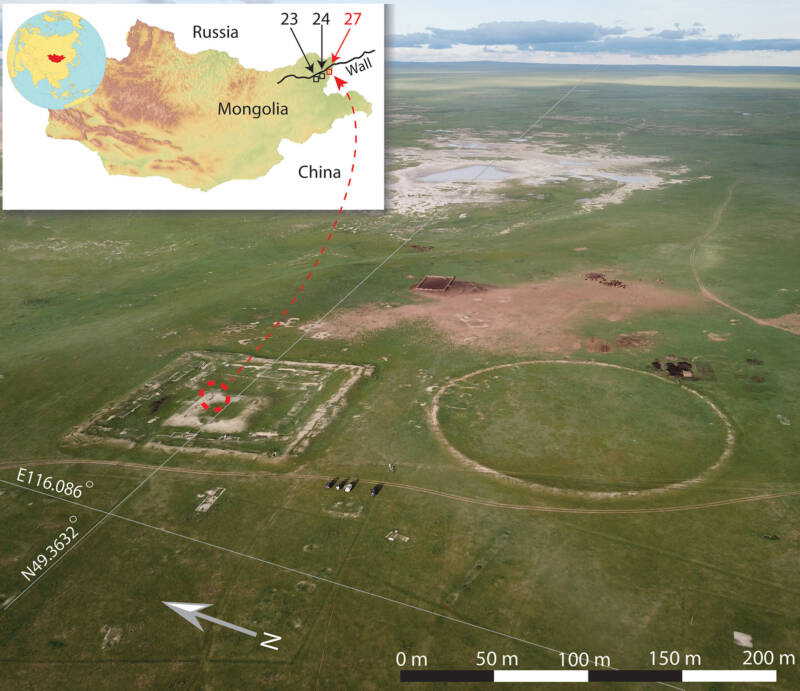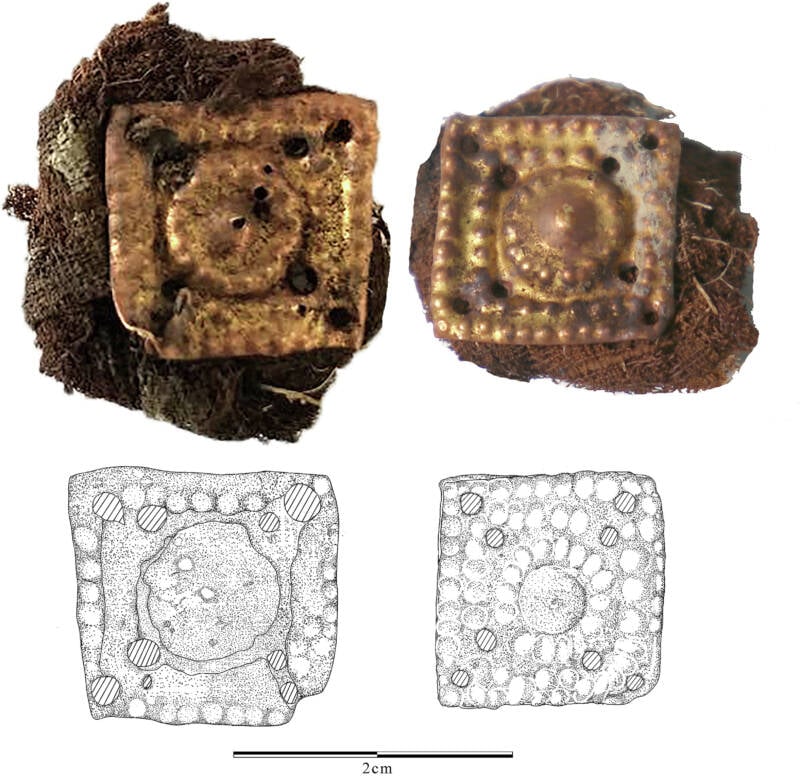This lavish burial could shed light on the little-understood period between the collapse of the Kitan Empire around 1125 C.E. and the rise of the Mongol Empire under Genghis Khan in 1206 C.E.

Chunag et al. 2024, Archaeological Research in AsiaThe remains of the Khar Nuur fortress, where the elite woman’s remains were found.
Hidden away inside an abandoned 1,000-year-old fortress in northeastern Mongolia, researchers recently made a shocking discovery. There, buried in the fortress walls, were the remains of an elite woman dressed in a yellow silk cloak — a woman whose remains pre-date even the rise of the Mongolian Empire’s founder, Genghis Khan.
Even more remarkably, researchers stumbled upon the burial by accident while surveying the fortress. The discovery of this burial could offer new insights into a relatively unknown period of time between the dynasties of the Kitan-Liao Empire and the Mongolian Empire that succeeded it.
Researchers Accidentally Discover The Burial Of A Mongolian Elite

Chunag et al. 2024, Archaeological Research in AsiaAn illustration detailing how the woman’s remains were oriented when they were discovered.
According to the study published in the journal Archaeological Research in Asia, researchers were conducting a survey at a fortress known as Khar Nuur when they came across the woman’s remains.
Khar Nuur was built sometime between the 10th and 12th centuries, during the height of the Kitan-Liao Empire. The fortress was once a part of a 500-mile “long wall” that stretched across the countryside, which was the original focus of this study. However, during the survey, researchers came across a tomb, hidden inside an enclosure in one of the fortress walls.

Chunag et al. 2024, Archaeological Research in AsiaVarious fragments of a bronze vessel found alongside the woman’s remains.
The woman’s remains were well preserved, and radiocarbon dating revealed that she had died between the ages of 40 and 60. She had been buried inside a coffin, dressed in a yellow silk robe, and silk textiles were placed under her head, while her skull was covered in a birchbark headdress.

Chunag et al. 2024, Archaeological Research in AsiaThe remains of the birchbark headdress.
Alongside the woman’s remains, researchers also came across a number of other valuable objects, further hinting at her elite status. Among these were golden earrings, coral and glass beads, golden ornamental plaques, a gold bracelet, various bronze fragments from vessels and framed objects, and fragments of a silver cup.
The Turbulent Historical Context Surrounding The Khar Nuur Burial
Furthermore, a preliminary bioarchaeologial assessment of the woman’s remains suggest she led a fairly active lifestyle and that she had lost most of her teeth before death, meaning she would have likely had difficulty chewing in her later years. Taken all together, the evidence here points to a fascinating, if turbulent, time in the history of the Mongolian steppe, where elites of the Kitan-Liao Empire were still highly regarded even as their dynasty tilted toward collapse.

Chunag et al. 2024, Archaeological Research in AsiaGolden ornaments found at the burial site.
“The Khar Nuur burial speaks to these turbulent histories,” study authors write. “Granted, our study focuses on a single mortuary context with limited excavation, but our results provide some insight to an understanding of Mongolian history during this roughly 80-year period between the Kitan demise (1125 C.E.) and Chinggis Khan‘s enthronement (1206 C.E.).”
Indeed, though much is known about Mongolian history in the period of Genghis Khan’s rule up until his death in 1227, through the rule of his grandson Kublai Khan, little is know about the 12th-century period.

Chunag et al. 2024, Archaeological Research in AsiaA gold bracelet and earrings found at the Khar Nuur burial.
The researchers go on to explain that this burial occurred in an eastern region that was “inhabited by groups participating in the 12th century Mongol emergence,” which would have likely meant the region was embroiled in significant political struggle.
“In light of this historical and archaeological background,” the researchers added, “the Khar Nuur burial was likely a funerary event carried out in a region experiencing a period of post-imperial destabilization… From the nature of this older woman’s burial, she probably belonged to a prestigious lineage of some political standing.”
What The Woman’s Remains Could Tell Is About The Khar Nuur Fortress
The nature of the burial within the fortress walls is also an interesting peculiarity. It’s hard to know how the Khar Nuur steppe nomads perceived the Kitan fortress, but it was likely long abandoned by the time this burial took place. However, the presence of the woman’s remains could support several theories.
The first theory suggests that a local steppe community might have occupied the fortress shortly before the burial, conducting the burial as a funerary rite to, in a sense, preserve the site as a part of their history.

Chunag et al. 2024, Archaeological Research in AsiaDetailed photographs of textiles found at the site.
The second theory puts more focus on the woman herself, suggesting that local nomads had buried her there specifically because of her high status. Perhaps her high status and the funerary ritual conducted to bury her was a show of status to other nearby communities as an assertion of presence and strength. The answer could also, of course, be some combination of all of these theories, or even none at all.
“As imperial authority diminished and nomadic steppe groups competed among themselves and with the distant Jin state,” the study’s authors concluded, “we might expect such combinations of social memory and identity assertion along with displays of elite prestige and power, all enacted during the poignant occasion of an older woman’s burial ceremony.”
After reading about the Khar Nuur burial, learn all about the fall of the Mongol Empire. Then, read about Genghis Khan’s descendants as well as his children.





